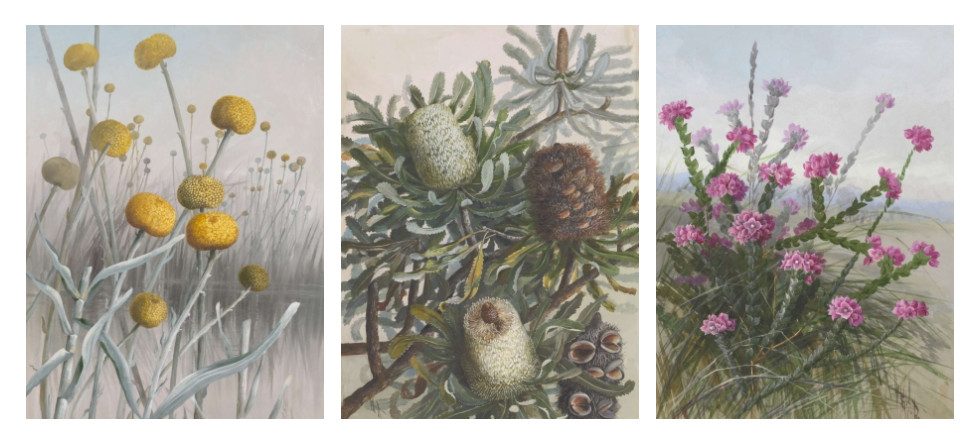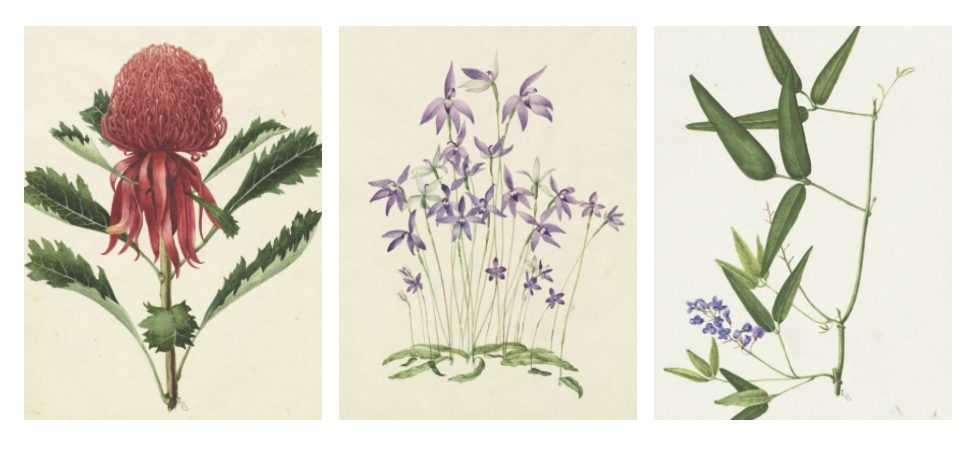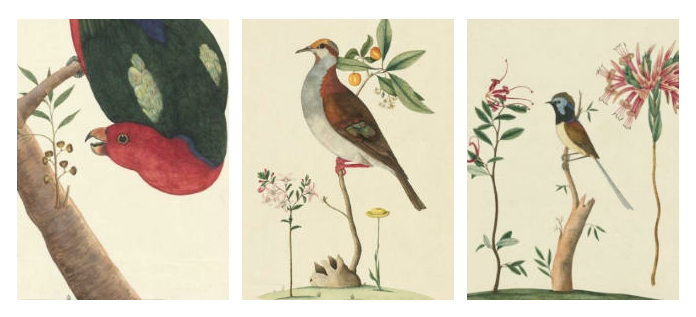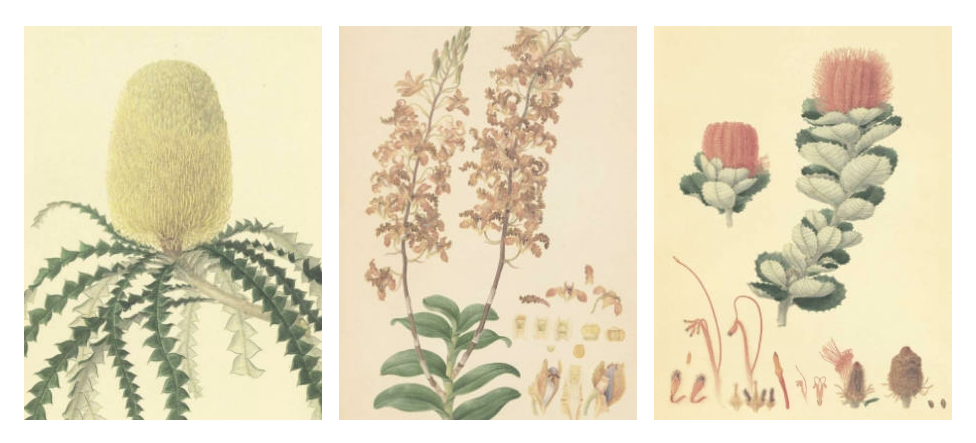Spring is here! A beautiful season which evokes re-birth and optimism, the awakening of nature providing us with an array of colours is a welcome sight as we emerge from lockdowns across the country.
As you may have guessed, when it comes to flowers, historic gardens and wilderness, the National Library of Australia and Trove has a lot to show.
Our online collections range from classic botanic drawings, diaries, oral histories, photographs, to plans of gardens.
Let's go on short walk through our virtual garden to see some of our most bloomin’ collections (channelling Peter Cundall, see Oral History record).
Ellis Rowan
Ellis Rowan (1848-1922) likely needs no introduction to artist and botanic enthusiasts alike. Melbourne born, Rowan painted wildflowers, birds, insects and butterflies. The majority of her paintings show Australian wildflowers, and also vivid portraits of the flowers and birds of Papua New Guinea and the Torres Strait Islands. Rowan's work is unusual in that they are not flat depictions of botanical illustrations, but are often expressive with shape, form, and depth and positioned in softened landscapes. She also integrates other elements like birds and insects into her work which only adds interest and context. Explore her work here.

Ellis Rowan (1848-1922) Pycnosorus globosus F.L.Bauer ex Benth., family Asteraceae, 1888(?), nla.cat-vn2848799
Ellis Rowan (1848-1922) Banksia serrata L.f. (1782), family Proteaceae, 1888(?), nla.cat-vn542809
Ellis Rowan (1848-1922) Boronia serrulata Sm., family Rutaceae, New South Wales, 1888(?), nla.cat-vn2299166
Adam Forster
Adam Forster (1852-1928), originally from Prussia, had a strong interest in botany. Like many renowned illustrative botanists, he travelled widely, collecting wildflowers and painting watercolours. A recollection from Thistle Harris (a naturalist) described his enthusiasm as a "schoolboy, scrambling over rocky precipices, pushing his way through dense scrub, walking miles without apparent fatigue".1 Admittedly this is a description that I can certainly appreciate in the spring. Like Forster, I can spend hours in nature looking for orchids, plants and animals only to realise by the end of the day how much time has time passed. Forster’s collection of 911 watercolours of Australian flowers, painted between 1916 and 1927 is digitised and available online here.

Adam Forster (1852-1928) Telopea speciosissima, 1916, nla.cat-vn717250
Adam Forster (1852-1928) Glossodia major and Glossodia minor, New South Wales, 1924, nla.cat-vn619400
Adam Forster (1852- 1928) Hardenbergia comptoniana, 1927, nla.cat-vn2138331
George Raper
George Raper (1769-1798), sailed on the ship Sirius, and is known as one of the most talented First Fleet artists. This collection shows birds and flowers of the Port Jackson area as Raper saw them between 1788 and 1790. Many are the first visual records by a European artist and reflect the awe and wonder of the sailors as they encountered Australian birds and plants for the first time. The King Parrot has to be one of Australia’s favourite native birds. I was lucky enough to have a King Parrot visit earlier this year in Canberra and perch on my hand. They are exceptionally inquisitive, social birds – in Raper’s illustration the King Parrot is depicted in dynamic profile, cheekily hanging half upside down, beak agape ready to prise open seeds. Raper’s King Parrot is arguably more characterful compared to other birds within this collection (see The Ducie collection of First Fleet art).

George Raper (1769-1798) King parrot (Alisterus scapularis) 1788(?) nla.cat-vn3579209
George Raper (1769-1798) Brush bronzewing (Phaps elegans), 1788(?) nla.cat-vn3579101
George Raper (1769-1798) Variegated fairy-wren (Malurus lamberti)] 1788(?) nla.cat-vn3579548
Ferdinand Bauer
Ferdinand Bauer (1760-1826) botanical artist, was selected by Joseph Banks to travel with Matthew Flinders' expedition around Australia. Sir Joseph Banks arranged for Bauer to be accompanied by the botanist Robert Brown, who was the appointed naturalist for the expedition on the Investigator. Bauer was known to be a bit of a perfectionist, often spending years working on his drawings to finite detail. Brown claimed that 'considering his minute accuracy, the number of drawings he has made is astonishing'. In fact, it was his perfectionism and high standards that virtually killed his Illustrationes Florae Novae Hollandiae (London, 1813) which was abandoned after publication of only fifteen of his exquisite plates.2 In any case, we have a fine collection of his work in the Library, all available digitally through the catalogue. Explore the artwork of Ferdinand Bauer.

Ferdinand Bauer (1760-1826) Banksia speciosa: showy banksia (date uknown) nla.cat-vn2288485
Ferdinand Bauer (1760-1826)Dendrobium discolour: golden orchid (date unknown) nla.cat-vn766400
Ferdinand Bauer (1760-1826) Banksia coccinea: scarlet banksia (date unknown) https://nla.gov.au/nla.obj-136232097/view
Want more spring in your life?
Although many of our botanical collections are available freely online, the key to our collections is a National Library digital login. With this you can have access to a number of electronic resources suitable for gardening, botanical research and study – ranging from gardening magazines, horticulture, cooking with native plants, and other information online that you may find useful and inspiring. Join the Library to get your digital login..
One of our popular online eResources, PressReader, has access to a number of magazine titles across the subjects which you can browse page-by-page in full colour on your computer or reader device (iPad, smart phone compatible). Some you may already be familiar with include:
If you wish to look further than the National Library botanical collections you can also find other naturalists and botanical artists online through various Australian museums and libraries on Trove. Great resources include:
- Australian Plant Index (Australian National Botanic Gardens)
- First Fleet Artwork Collection (Natural History Museum)
- Biodiversity Heritage Library & Joseph Henry Maiden Botanical Texts (University of Sydney)
- The Australasian Virtual Herbarium
Or, if you want to brighten up your home with some indoor botanicals, give our origami flowers a try! With both beginner and intermediate options, anyone can bring spring to life with these quick and easy origami flowers.
Origami tulip-easy.pdf (87.78 KB)
Origami rose-intermediate.pdf (366 KB)
If you have any questions or would like more information please contact us through our Ask a Librarian service.
References
- National Library of Australia. Guide to selected collections: Forster Collection, 2019 www.nla.gov.au/collections/guide-selected-collections/forster-collection viewed October 2021
- L. A. Gilbert, 'Bauer, Ferdinand Lukas (1760–1826)', Australian Dictionary of Biography, National Centre of Biography, Australian National University, www.adb.anu.edu.au/biography/bauer-ferdinand-lukas-1754/text1951, published first in hardcopy 1966, accessed online 15 October 2021